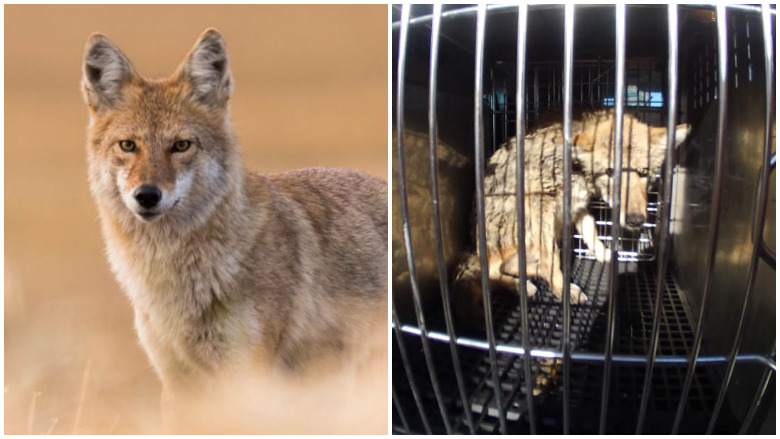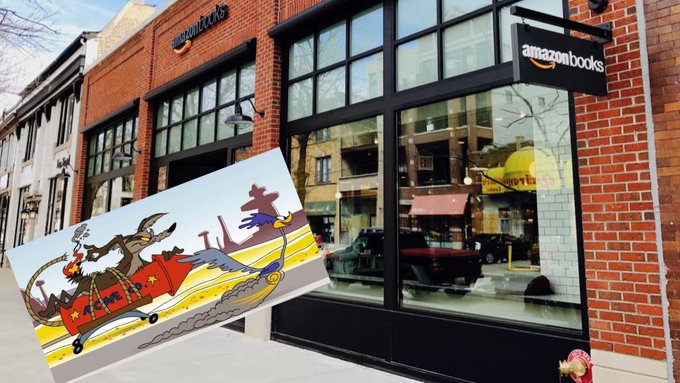
Chicago Animal Care and Control Two Chicago coyote attacks have frightened Chicago.
Chicago coyote attacks are frightening residents after a coyote attacked a small boy, and then a man reported that a coyote bit him, all in the same week of January 2020. There has been a flurry of sightings, including video of a limping coyote; police are chasing coyotes; animal control rescued one from the lake; and people are sharing pictures of sightings on social media.
In fact, here’s video of Chicago police chasing a coyote through the streets.
Authorities sought to douse community fears in a press conference. Before the recent attacks, Illinois had seen no coyote attacks on humans for the last 30 years, according to the Chicago Animal Care and Control’s coexistence plan. In the news conference, CACC officials said it had been at least 10 years since a Chicago coyote attacked a person.
The plan says that coyotes are “protected as a furbearer” in Illinois, which means that problem coyotes in urban areas can only be removed with a nuisance wildlife permit. If they attack people, the game changes, and the coyotes are tracked down, tranquilized, and released elsewhere.
“They are part of our ecosystem here in Chicago. They have lived among us for generations… Generally they do not want any contact with people,” Chicago Animal Care and Control executive director Kelly Gandurski said in the press conference. “Any attack is very, very rare…”
She added, “We have no evidence that there’s a larger coyote population. We looked at our calls for the same time period over the last three years. There’s a slight uptick in calls and sightings.” But she said it’s not clear whether that’s due to media reports driving calls. She said coyotes are usually fearful of humans.
“Coyote are becoming increasingly common in cities. Even in densely populated areas, coyotes maintain an avoidance of humans and potential for human-coyote interaction is low,” Chicago Animal Care and Control said in a statement. CACC provides tips for avoiding problems with coyotes, which you can read later in this story.
You can read Chicago’s coyote management and coexistence plane here. The plan says that coyotes are “adapting especially well to densely populated urban spaces.” One expert estimated that there were about 2,000 coyotes in Chicago in 2014, but in the press conference officials said they couldn’t give a number now. Researchers believe that the coyote population will continue to grow in Chicago because coyotes “have no existing predators in urban spaces and adapt around human populations.”
Coyote attacks on humans are rare nationwide as well. In recent years, there were “150 documented attacks in North America in entirety,” the report says, but pets are in greater peril. Attacks on pets in the Chicago area spiked dramatically from 1990 to 2005, according to the Urban Coyote Research Project. January was the most likely month for coyotes to attack dogs. “Between 1990 and 2004, the number of attacks on pets in the Chicago metropolitan area increased from 0-2 attacks per year to 6-14 reported attacks per year,” the project found in one study. That project is also called The Cook County Coyote Project and it’s a “comprehensive study of coyotes in Chicago metropolitan areas” that launched in 2000. You can see its research reports here.
Here’s what you need to know:
1. A Coyote Bit a Boy Outside the Nature Museum
In a frightening attack, a 6 year old boy was bitten by a coyote outside the Peggy Notebaert Nature Museum in the Lincoln Park area. Two DePaul students came to the boy’s aid, according to NBC Chicago, which added that a caregiver with the boy was trying to get the coyote off him.
According to CBS Chicago, the attack took place on January 8, 2020, around 4 p.m., and the child was bit on the head. According to CNN, the boy is in stable condition at the hospital.
Shortly before the boy was bitten, a man took a video of a limping coyote not far from the museum, but it’s not clear whether it’s the same one. Chicago police were giving chase.
Chicago Animal Care and Control executive director Kelly Gandurski said in a news conference that coyotes are protected by Illinois state law. Thus, CACC doesn’t remove coyotes because of sightings alone, but when a coyote attacks a person, that’s different.
“Our team has been out canvassing the area for any sightings,” she said. “There were also reports of small dogs being attacked as well.” It’s not clear whether the limping coyote was the one attacking dogs, she said. She said the family didn’t report the coyote that attacked the boy as having a limp.
The child was “reportedly attacked by a coyote while walking on the walking path.” His caretaker and two good Samaritans “got the coyote off the child” and the animal ran away, she said. There was another sighting, and Chicago police were also out canvassing the area.
2. A Man Said a Coyote Bit Him in the Buttocks a Couple Miles Away
According to CNN, later that same night, a 32-year-old man “said a coyote bit his buttocks while he was walking near Northwestern Hospital.”
The man is in good condition at the hospital; he was attacked about 2.6 miles away from the Lincoln Park incident, but it’s not clear whether the same coyote was involved, CNN reports.
However, Gandurski said in the press conference that authorities had not been able to confirm that it was actually a coyote bite.
USA Today reported that a coyote “also was spotted Thursday afternoon in Oz Park,” and two schools locked down as a result.
The Coyote Research Group also did a nationwide study of coyote attacks on humans from 1985 to 2006. “We located accounts of 142 coyote attack incidents, resulting in 159 human victims,” the group wrote. “These attacks took place over a wide geographic area, including 14 states in the U.S. and 4 provinces in Canada. Most attacks, however, occurred in the western U.S., with almost half of the attacks occurring in California and another large portion (14%) occurring in Arizona. We did not find records of any attacks on humans within the Chicago metropolitan area (or even within the state of Illinois).”
3. People Took to Social Media to Report Sightings
On January 7, 2020, Animal Care and Control reported that a coyote was rescued from the water, writing, “This afternoon, CACC received a call for an assist from the Chicago Fire Department Marine Unit / Dive Team who saw a coyote in Lake Michigan. CACC dispatched inspectors to the location. When CACC Inspectors arrived, CFD was already able to pull the young coyote from the water, put him on a gurney with blankets to warm him up! The coyote was transported to CACC, and our partner Flint Creek Wildlife Rehabilitation will be picking him up this afternoon. We want to thank CFD for heroic efforts to show kindness and care to this young pup! #NotJustCatsandDogs #Coyotes #TeamWork.”
“I saw this coyote today in the Near North Area. This is the intersection of Wells & Oak Streets. This is right across the street from Walter Payton High School, and very near Moody Bible College. Yes, I know coyotes are in the city, but I was surprised to see him at Wells & Oak,” wrote a man on Facebook. He shared this picture:
One man took to Twitter to complain, “When I come home from school, I expect serious news. Shootings in chicago, unions on strike, a new ridiculous income tax hike. But what do I see tonight? A F*CKING COYOTE?! 10 officers on my screen rn chasing a coyote through Chicago. HELLO?”
Some people were listening to coyote chatter on the police scanner. “Sounds like someone was reporting a coyote outside their home. Zone 4. #ChicagoScanner,” wrote one woman. She then added, “CPD spotted it. They called animal control to come get it.”
Other people decided to make jokes.
“I mean I heard like 10 minutes on the radio about turkeys in Moorhead and there’s been a bunch of tweets about coyotes in Chicago and I’m like, I think people need to get out of the city more often,” wrote one man.
4. There Are Steps You Can Take to Prevent Problems With Chicago Coyotes
According to Chicago Animal Care and Control, there are certain things people can do to prevent problems with coyotes. “To maintain a safe distance, homeowners are instructed to limit the availability of food on their property and haze individual coyotes in the case of direct encounters. If followed by residents, the likelihood of coyote-human interactions or pet attacks is low and coexistence is possible,” the organization wrote.
The group offers these tips:
1. Do not feed coyotes. Unintentional and intentional feeding “are the leading causes of coyote habituation – when a coyote becomes uncharacteristically comfortable around humans,” the organization advises. Thus, people shouldn’t directly feed coyotes or leave their garbage out for long periods of time. Coyotes may also be drawn to outdoor bird feeders.
2. Monitor pets. The group says that “coyotes are not naturally inclined to approach homes or areas with pets.” However, coyotes will prey on pets if they don’t have enough food. People should put their pets on leashes and monitor them. Domesticated cats should be kept inside.
3. Hazing. What should you do if you encounter a coyote? Don’t run away, the group suggests. “Shouting, waving, and throwing items are forms of hazing and will instill fear in the animal, preventing the likelihood of future attacks. Coyotes are more likely to engage in negative behavior during May, which is “pupping season.” Carrying a noisemaker to shake at a coyote is suggested.
4. Report aggressive coyotes. What are signs of aggression in coyotes? “Unprovoked barking, hackle raising, snarling, and growling” are signs a coyote is aggressive, and city officials should learn about it.
Read the entire tip sheet here.
“Coyotes, wolves, foxes and domestic dogs belong to the Canidea family,” says Chicago’s coyote management plan. “Most coyotes weigh approximately 30-35 pounds, although their long legs and thick fur make them appear larger. A coyote’s diet is usually composed of small rodents, fruit, and birds. Some coyotes will prey on larger animals, such as deer, or other available food sources depending on available food sources. In an urban setting, a coyote typically lives to about the age of 3, although in captivity their lifespan is much longer. The most common cause of death for urban coyotes is from motor vehicle accidents.”
5. Coyotes Are Now Found in All States & Are Increasingly Moving Into Urban Areas
“Coyotes are now found in all states in the U.S. except Hawaii and have become well established in nearly every ecosystem,” Chicago’s coyote management plan says.
“It is important to keep in mind that coyotes have been interacting with and adapting to people since the first development expanded across North America. Due to their intelligence and adaptability, in addition to extensive urbanization and the subsequent decline of larger predators, coyotes have successfully expanded their range across Chicago.”
According to the plan, “the early rise of U.S. metropolitan areas alienated coyote populations; however, they began reintroducing themselves in the late 20th century, beginning in California and moving eastward. The urban presence of coyotes is a nationwide phenomenon, as is the case in Chicago.”
The plan says that coyotes “tend to prefer more open areas and spaces with natural shielding from human activity. It is not rare for an individual or group to settle in urban parks offering greenspace and preferred habitat. Research is not conclusive as to the cause of coyote’s presence in urban spaces. Their success in urban regions is either due to an overall benefit to situating near high concentrations of people, or a response to urban sprawl and increased habitat fragmentation subsequently causing natural habitat loss.”
READ NEXT: Authorities Believe Flight 752 Was Shot Down by an Iranian Missile.


